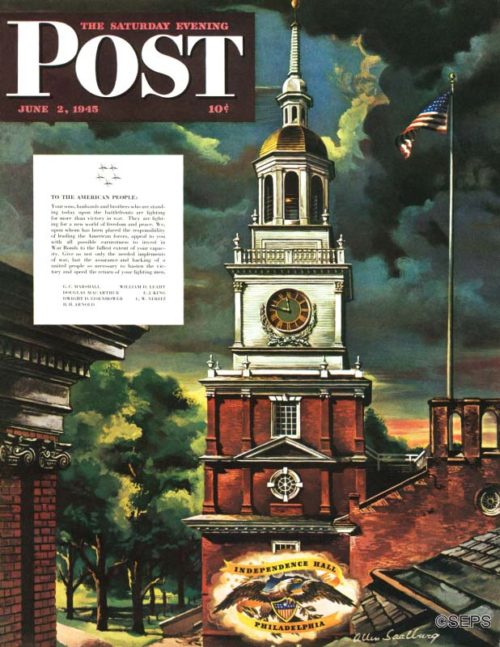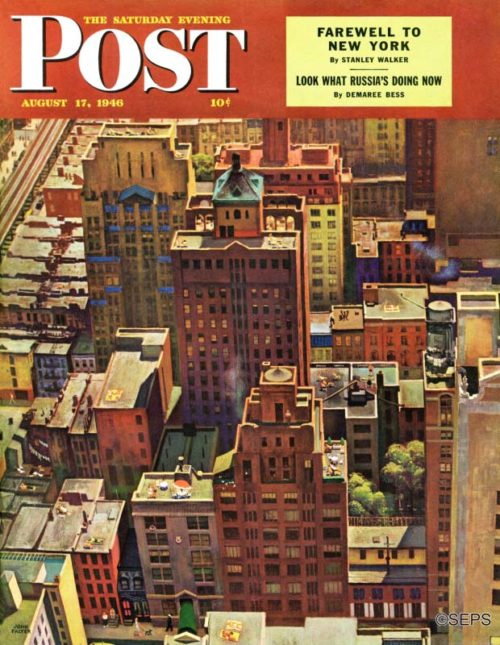Cover Gallery: Summer in the City

Allen Saalburg
June 2, 1945
Independence Hall, more than any other structure, is a symbol of American perseverance and love of liberty. Saalburg’s painting is a view of Independence Hall looking west. The building at the left is The American Philosophical Society, The Post’s original offices were directly behind the trees in the left foreground.

John Falter
August 17, 1946
This 1946 view is from the fifty-fourth floor of the Chrysler Building, looking south. There were sun bathers on almost every roof, stewing, frying and boiling in the early afternoon sun.

John Falter
July 11, 1953
In New York’s famous wilderness, Central Park, you can hike, boat, bicycle, ride horseback, woo a wife, climb small mountains, get lost in small woods, and on the zoo trail meet many wild animals including people who make faces at monkeys. If you don’t think New Yorkers get more exercise than country people, buy some liniment and see how far you can trudge in the park without crying, “Help! Taxi!”

John Falter
June 5, 1954
Down out of the city’s cubbyholes come the inhabitants to enjoy some fresh air and automobile fumes. On second thought, ignore that glum remark, for actually these folks are having a swell time.

John Falter
May 26, 1956
When artist John Falter was risking his boyhood, he used to take off on a bag swing from the roof of a shed, part of his joy being to see if he could avoid demolishing his bones against the shed on the way back. Recently when Falter was strolling along Belvedere Island, admiring the grace of Golden Gate Bridge across the azure bay, he happily discovered that modern kids still relax in the mellow old hair-raising way.

Ben Kimberly Prins
June 9, 1956
See the sociable traffic officer of Friendly City chatting warmly with strangers from a distant clime. The amiable man has even got out of his car to ask them their names and where they may be from. Will he hospitably invite them to pause awhile and be personally greeted by an official of the municipality? What is he writing for them—a complimentary ticket to the policemen’s ball? In any event, the travelers in Ben Prins’ genial scene will always carry an emotion in their hearts for Southfield, and if they ever return, will pass through at greatly reduced speed, the better to enjoy the changing beauty of its traffic lights and the curving artistry of the paintings on its pavements—and, to be sure, the better to see whether their old friend in blue is still there.

George Hughes
May 9, 1959
The day is Sunday, and this is a midtown Manhattan beach scene. As our fair lady enjoys a exposure to sunbeams, she should take care lest it degenerate into erythema solare, an inflammation of the skin.

John Falter
September 23, 1961
Our cover scene is in Kansas City, “the gateway to the Southwest,” and you are looking at the intersection where U.S. 50, gateway to the Country Club Plaza shopping center, crosses J. C. Nichols Parkway. This elegant community of shops was conceived and built by Jesse Clyde Nichols (1880-1950), to whom the fountain in the foreground is a memorial. The scene appealed to artist John Falter because the Old World architecture seemed to symbolize our nation’s roots—which is not to deny the notion expressed by lyricist Oscar Hammerstein in Oklahoma! that “everything’s up-to-date in Kansas City.”